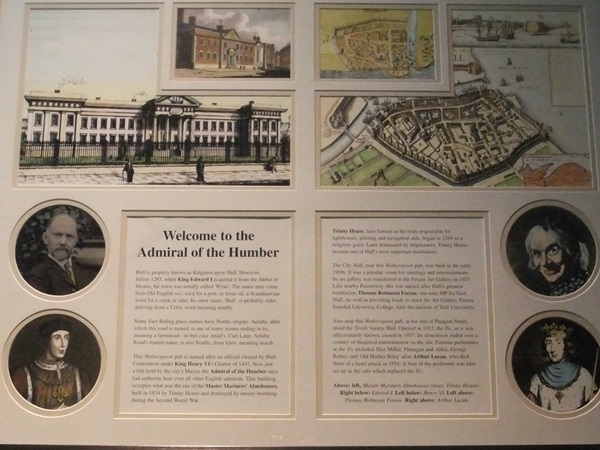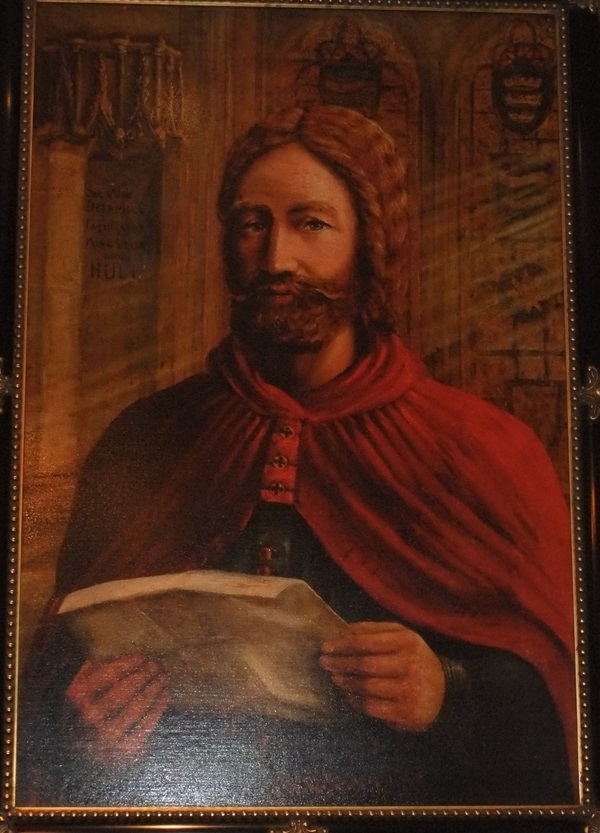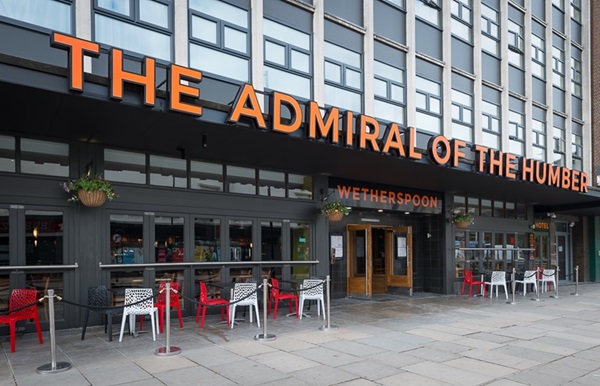The name of this pub recalls the royal charter granted to Hull Corporation, in 1447, to elect a suitable and discreet man as Admiral of the Humber. The city’s Lord Mayor is still elected to that office, although its power no longer exists. This site is part of Grosvenor House which, itself, was built on the site of the Master Mariner Almshouse, erected in 1834. It was known to the inmates as The Ship, from the carving of a ship’s hull on top of this grand building. In 1937, there were 48 inmates. Four years later, the almshouse was destroyed by enemy action, with the site cleared in the 1950s.
Prints, illustrations and text about The Admiral of the Humber.

The text reads: Hull is properly known as Kingston upon Hull. However, before 1293, when King Edward I acquired it from the Abbot of Meaux, the town was usually called Wyke. The name may come from Old English wic, used for a port, or from vik, a Scandinavian word for a creek or inlet. Its other name, Hull, is probably older, deriving from a Celtic word meaning muddy.
Many East Riding place-names have Nordic origins. Anlaby, after which this road is named, is one of many names ending in by, meaning a farmstead – in this case Anlaf’s Carr Lane, Anlaby Road’s former name, is also Nordic, from kjarr, meaning marsh.
This Wetherspoon pub is named after an official elected by Hull Corporation under King Henry VI’s Charter of 1447. Now just a title held by the city’s Mayor, the Admiral of the Humber once had authority here over all other English admirals. This building occupies what was the site of the Master Mariners’ Almshouses built in 1834 by Trinity House and destroyed by enemy bombing during the Second World War.
Trinity House, later famous as the body responsible for lighthouses, piloting and navigation aids, began in 1369 as a religious guild. Later dominated by shipmasters, Trinity House became one of Hull’s most important institutions.
The City Hall, near this Wetherspoon pub, was built in the early 1900s. It was a popular venue for meetings and entertainments. Its art gallery was transferred to the Ferens Art Gallery in 1927. Like nearby Ferensway, this was named after Hull’s greatest benefactor, Thomas Robinson Ferens, one-time MP for East Hull. As well as providing funds to stock the Art Gallery. Ferens founded University College, later the nucleus of Hull University.
Also near this Wetherspoon pub, at the end of Paragon Street, stood the Tivoli Variety Hall. Opened in 1912, the Tiv, as it was affectionately known, closed in 1957. Its demolition ended over a century of theatrical entertainment on the site. Famous performers at the Tiv included Max Miller, Flanagan and Allen, George Robey, and Old Mother Riley alias Arthur Lucan, who died there of a heart attack in 1954. A bust of the performer was later set up in the café which replaced the Tiv.
Above: left, Master Mariners Almshouses (inset, Trinity House)
Right below: Edward I
Left below: Henry VI
Left above: Thomas Robinson Ferens
Right above: Arthur Lucan.
A painting of Sir William de la Pole, by Thomas Wilridge, in 1880.

The Admiral of the Humber is one of the titles awarded to the mayors of the Hull. The position of Mayor of Kingston upon Hull was established in 1332 by Edward III; the first mayor being William de la Pole.
Sir William de la Pole (died 21 June 1366) was a wealthy wool merchant in Hull, a royal moneylender and briefly, Chief Baron of the Exchequer. He established the de la Pole family as one of the primary houses of England through his mercantile and financial success, as well as initiating the foundation of the Charterhouse monastery in Hull.
External photograph of the building – main entrance.

If you have information on the history of this pub, then we’d like you to share it with us. Please e-mail all information to: pubhistories@jdwetherspoon.co.uk